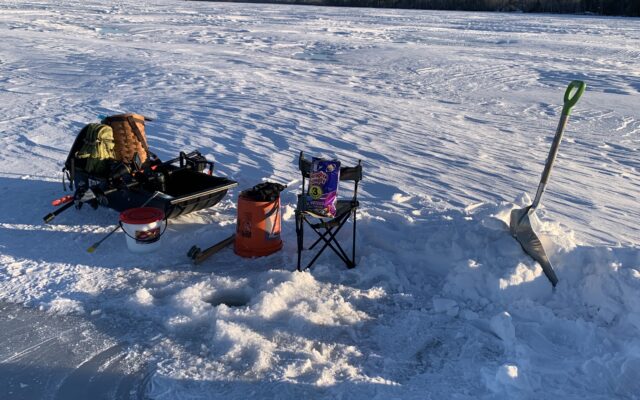
How to stay warm on your next ice fishing trip
By Pete Warner, Bangor Daily News Staff
Contending with the cold is part of ice fishing. And given the length of Maine’s “hardwater†season, anglers can face a wide range of weather conditions.
However, it’s important to realize that in cases of extreme cold, especially if it is windy, you could put yourself in danger of frostbite.
Ice fishing is a pastime that requires cold temperatures and the ice they produce to provide safe conditions. However, us anglers need to prepare for the weather.
The basics of staying warm on the ice are similar to undertaking any outdoor activity. It requires proper clothing and footwear.
Moisture-wicking base layers made of polyester or other manmade materials, under a layer of wool and then topped by a jacket, snow pants or wool pants, will keep you the warmest. Layers of thinner garments, especially if they have zippers, enable you to better regulate your temperature based on your level of activity.
Remember, the cotton clothing you might prefer during the summer is not suitable for winter pursuits. “Cotton kills,†the saying goes, because it retains moisture, which will eventually make you cold.
You should consider gloves, mittens, socks, tops, pants, hats, scarves and jackets made of wool. They are almost always excellent choices.
Water-resistant bib overalls or pants block the wind and keep your other layers dry. Wool pants can be a good choice, because they’ll help keep you warm, even if they get a little wet.
Keeping your ears and face mostly covered on especially cold days will make your outing much more tolerable — especially if you’re follicly challenged like some of us. The helmet-style coverings, which protect the head, but provide an opening for the eyes, nose and mouth, are pretty effective.
If you have a long walk to access your fishing area, keep in mind that you’re going to warm up along the way, especially if you’re lugging a Jet Sled full of gear. In that case, it might be worth saving a layer or two to put on after you have made the trek.
Wool socks are the ticket inside your boots, which should shed water easily. A single pair of good socks probably outperforms multiple layers, which can cause perspiration and reduce air flow.
I’m partial to my Muck boots, which keep my feet dry and allow me to tromp through the snow. It can be helpful to wait until you arrive at your destination to put on your socks and boots, which will help you avoid overheating before you hit the ice.
A good boot tread will often give you the needed grip on the ice, but there are numerous products that feature some type of metal spikes, such as crampons, which provide better footing on bare ice.
The other place the cold is likely to bite you is your fingers. Some people like the neoprene gloves, which allow decent dexterity and keep your hands dry when putting them into the water.
I’m a fan of using slightly oversized mittens and then handling the baiting of hooks and landing of fish with my bare hands. It doesn’t take long for a hand immersed in the water to become painfully cold once it’s exposed to the air.
Another advantage of mittens is that you can slide one of those little hand warmers in each one. They’ll stay warm in there pretty much all day and your fingers will thank you.
It’s always a good idea to pack an extra pair of gloves or mittens, since there’s a decent chance your original pair will get wet.
Hand or toe warmers can be beneficial inside your boots, assuming that there’s enough room to slip one on top of your sock.
It is also a good idea to pack a couple of extra clothing items — maybe a shirt, pants and a dry pair of socks — just in case you wind up getting wet.
Once you have all that covered, cold days on the ice are much more tolerable if you have someplace to get out of the wind. Diehard ice anglers often have an ice shack or a portable shelter at their preferred spot.
Having a warm place to retreat from frigid temperatures and biting winds can make your outing much more comfortable — the number of flags and fish caught notwithstanding.
Some anglers run a small wood stove, a Coleman-style gas cook stove or a propane element heater. It doesn’t take long to warm up a shack and it may even get a little too hot in there, if you’re not careful.
If it’s brutally cold, and your shelter is so equipped, you also can jig for fish from inside. Best of both worlds.
Even without supplemental heat, having a shack or a blind will keep you out of the wind and your feet off the ice surface.
If it’s not prohibited by local ordinances, finding a spot to build a small fire, or using a portable barbecue grill, can produce enough heat to take the chill off — or grill a hotdog.
If you’re out fishing and the cold becomes intolerable, you can always take a break. Pull your traps (assuming that you can’t keep them under your immediate supervision) and head back to your vehicle for a brief warm-up or to change into some dry clothes.
Then you’ll be ready to head back out and fish a little more.
Dealing appropriately with the cold is the key to having an enjoyable day on the ice. Having a good plan that includes warm clothing and footwear, and access to a shelter, should help you get the most out of the experience.
Oh, and don’t forget to take along some water to avoid dehydration, and a few snacks.